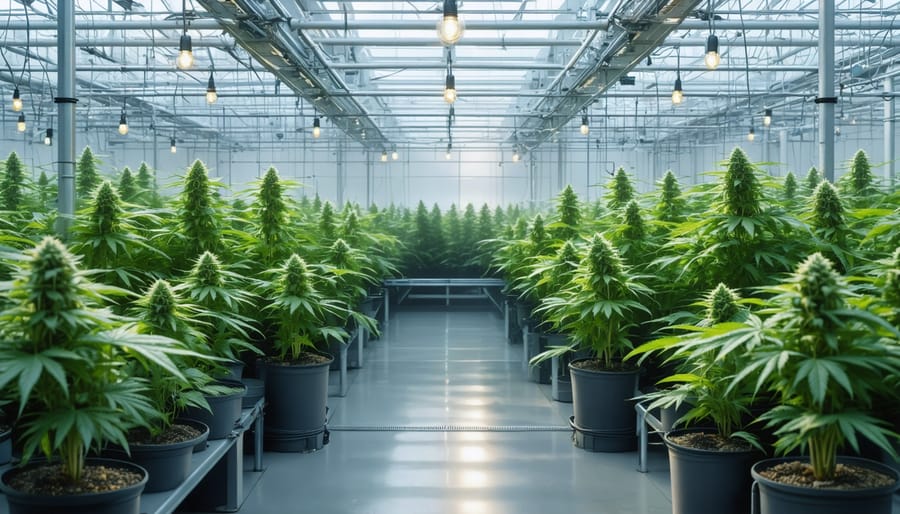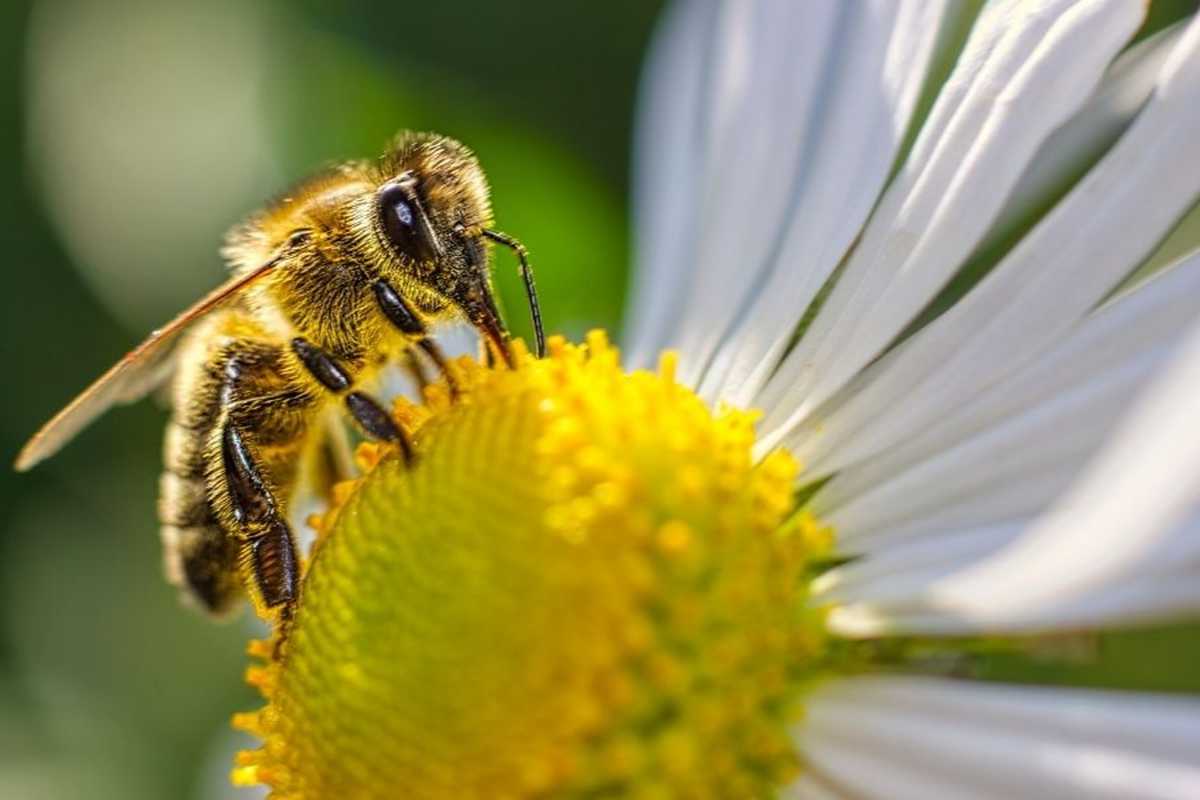The environmental footprint of cannabis cultivation demands urgent attention as the industry expands globally. While BudPop and other industry leaders pioneer sustainable practices, recent environmental impact studies reveal both challenges and opportunities. Indoor cannabis operations consume as much electricity annually as 2 million average American homes, while outdoor cultivation raises concerns about water usage, habitat disruption, and pesticide runoff.
This surge in environmental research arrives at a crucial moment, as worldwide cannabis legalization accelerates and climate change intensifies. Scientists now document how different growing methods affect carbon emissions, water resources, and local ecosystems. Their findings highlight the urgent need for sustainable cultivation practices that balance industry growth with environmental stewardship.
Understanding these environmental impacts has never been more critical for policymakers, cultivators, and consumers alike. As the industry matures, evidence-based research guides the development of eco-friendly cultivation methods, innovative energy solutions, and responsible water management practices that could transform cannabis into a model for sustainable agriculture.
Energy Consumption in Indoor Cannabis Operations
Lighting and Climate Control Systems
Indoor cannabis cultivation facilities rely heavily on artificial lighting and climate control systems, which significantly contribute to the industry’s environmental footprint. Modern grow operations typically employ high-intensity discharge (HID) lamps or LED lighting systems, running 12-18 hours daily during different growth phases. These lighting requirements, combined with ventilation and temperature control needs, can consume up to 2,000 kilowatt-hours per pound of product – comparable to the energy usage of 30 California households.
Similar to recent energy initiatives in Canada, progressive cultivators are transitioning to energy-efficient LED technology, which can reduce electricity consumption by 40-50% compared to traditional HID systems. However, the challenge extends beyond lighting to HVAC systems necessary for maintaining optimal growing conditions.
Climate control systems must maintain specific temperature ranges (20-25°C) and humidity levels (40-60%) year-round. These systems typically account for 50% of a facility’s total energy consumption. The constant need for dehumidification, air circulation, and temperature regulation creates a substantial carbon footprint, estimated at 4.3 metric tons of CO2 emissions per kilogram of dried cannabis produced.
To address these environmental challenges, industry leaders are implementing smart climate control systems, energy recovery ventilators, and renewable energy solutions. These innovations not only reduce environmental impact but also lower operational costs, demonstrating that sustainable practices can align with business efficiency.
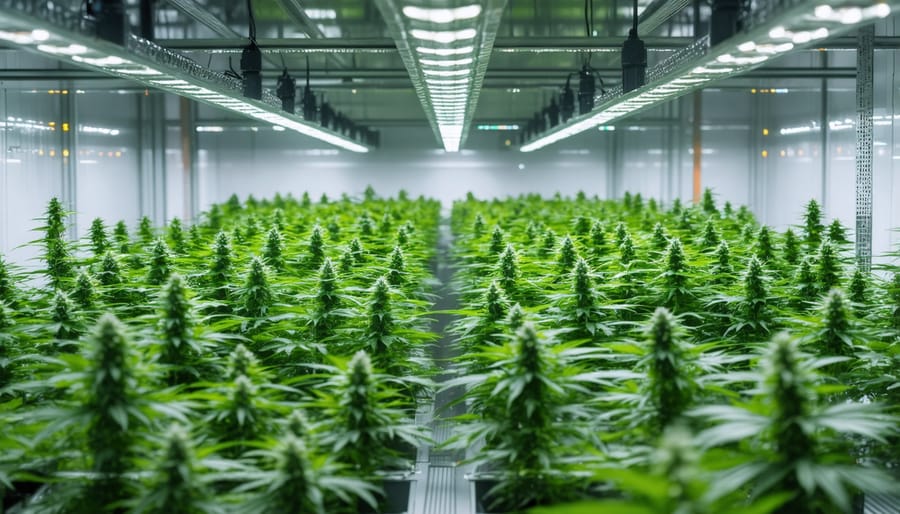
Carbon Footprint Metrics
Recent studies reveal that indoor cannabis cultivation generates significant greenhouse gas emissions, primarily due to intensive energy requirements for lighting, ventilation, and climate control systems. Research conducted by Colorado State University found that indoor cannabis operations can produce up to 5.2 tons of CO2 emissions per kilogram of dried flower, equivalent to the emissions from 3 million cars annually.
The carbon footprint varies considerably based on geographic location and local energy sources. In regions relying heavily on coal-powered electricity, the emissions can be up to 10 times higher compared to areas using renewable energy sources. Temperature control represents the largest share of energy consumption, accounting for approximately 50% of the total carbon footprint in indoor facilities.
Advanced monitoring has shown that a typical 5,000-square-foot indoor cultivation facility consumes as much electricity as 80 average households. This intensive energy use translates to approximately 2,000 kg of CO2 emissions per pound of product. However, facilities implementing energy-efficient technologies and renewable energy sources have demonstrated potential reductions of up to 40% in their carbon footprint.
These metrics underscore the urgent need for sustainable cultivation practices and energy-efficient technologies in the cannabis industry. Progressive operators are already adopting LED lighting, smart HVAC systems, and renewable energy solutions to minimize their environmental impact while maintaining product quality.
Water Resource Impact Assessment
Water Consumption Patterns
Water consumption in cannabis cultivation represents one of the most significant environmental challenges facing the industry today. Studies indicate that a single cannabis plant can require up to 22.7 liters of water per day during its peak growing season, which significantly exceeds the water requirements of many traditional agricultural crops.
Indoor cultivation facilities typically demonstrate higher water efficiency compared to outdoor operations, primarily due to controlled environments and water recycling systems. However, the total energy footprint of indoor facilities often offsets these water conservation benefits. Recent research shows that implementing drip irrigation systems can reduce water usage by 30-50% compared to traditional irrigation methods.
Several innovative water management strategies have emerged in response to these challenges. These include soil moisture sensors, automated irrigation systems, and water capture technologies that collect and reuse condensation from HVAC systems. Some cultivators have successfully implemented hydroponic and aeroponic systems, which can reduce water consumption by up to 90% compared to traditional soil-based methods.
Regulatory frameworks in various regions now mandate specific water efficiency standards for cannabis operations. For example, some jurisdictions require growers to demonstrate sustainable water sourcing and implement water conservation plans before receiving cultivation licenses. These measures, combined with industry-led initiatives, are helping to establish more sustainable water consumption patterns in cannabis cultivation.
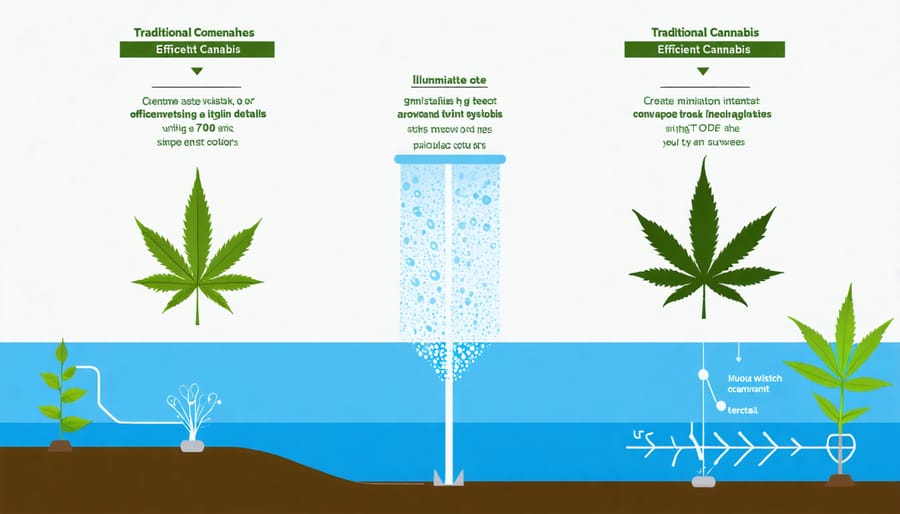
Watershed Effects
Cannabis cultivation significantly impacts local watersheds and aquatic ecosystems, particularly in regions where water resources are already stressed. Studies indicate that a single cannabis plant can consume up to 6 gallons of water per day during the growing season, putting substantial pressure on local water supplies. This intensive water usage, combined with improper irrigation practices, has led to serious water pollution concerns in many cultivation areas.
The environmental impact extends beyond water consumption. Unauthorized water diversions for cannabis cultivation have been documented to reduce stream flows by up to 23% in some watersheds, threatening native fish populations and aquatic biodiversity. These diversions are particularly harmful during dry seasons when water levels are naturally low.
Chemical runoff from fertilizers and pesticides used in cannabis cultivation can contaminate groundwater and surface water systems. Research has shown elevated levels of nitrogen and phosphorus in waterways near cultivation sites, leading to algal blooms and reduced oxygen levels in affected water bodies.
To protect watershed health, implementation of water-efficient irrigation systems, proper drainage management, and sustainable farming practices is crucial. Some cultivators have successfully adopted water recycling systems and rain catchment methods, demonstrating that environmentally responsible cannabis cultivation is possible when proper measures are taken.
Land Use and Soil Health
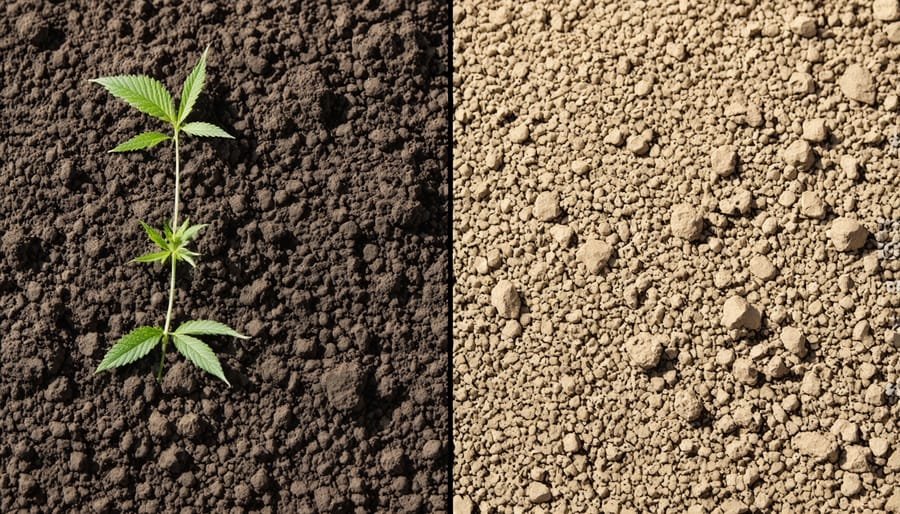
Soil Degradation Concerns
Cannabis cultivation’s impact on soil health has emerged as a significant environmental concern, with studies revealing several challenges to long-term soil sustainability. Intensive farming practices can lead to soil compaction, reduced organic matter content, and disrupted microbial communities essential for healthy soil ecosystems.
Research indicates that repeated cannabis cultivation in the same location can deplete vital nutrients, particularly nitrogen and phosphorus, requiring careful soil management strategies. The heavy nutrient demands of cannabis plants, combined with conventional farming methods, may accelerate soil degradation processes.
However, sustainable solutions are gaining traction within the industry. Implementing crop rotation, using cover crops, and adopting organic farming practices can help maintain soil health. Some cultivators are successfully utilizing regenerative agriculture techniques, which focus on building soil organic matter and promoting biodiversity.
To preserve soil quality, experts recommend regular soil testing, balanced fertilization programs, and minimal tillage practices. These approaches not only protect soil resources but also contribute to higher quality yields and reduced environmental impact, demonstrating that environmental stewardship and profitable cultivation can coexist.
Habitat Disruption
Cannabis cultivation, particularly large-scale operations, has sparked growing concern over its impact on local biodiversity and ecosystem stability. Studies reveal that land clearing for cannabis farms often leads to habitat fragmentation, disrupting wildlife corridors and threatening native species’ survival. In California’s Emerald Triangle, researchers have documented significant forest clearing, with some areas losing up to 100 acres of native vegetation annually.
The introduction of intensive farming practices can alter soil composition and disturb natural wildlife patterns. Security fencing and artificial lighting systems further compound these effects by restricting animal movement and disrupting nocturnal species’ behavior. Additionally, the use of pesticides and rodenticides in cannabis cultivation has been linked to secondary poisoning in predator species, creating ripple effects throughout the food chain.
Conservation efforts have identified several endangered species directly affected by cannabis operations, including spotted owls and Pacific fishers. However, implementing wildlife-friendly farming practices, such as maintaining buffer zones and wildlife corridors, can significantly minimize these impacts while maintaining productive cultivation.
Chemical Use and Pollution
Pesticide Environmental Impact
Recent studies reveal significant concerns about pesticide use in cannabis cultivation and its environmental impact. Research conducted across multiple growing regions shows that chemical runoff from cannabis farms can contaminate local water systems and affect wildlife populations. A 2022 study found that commonly used pesticides in cannabis cultivation can persist in soil for up to three years, potentially harming beneficial insects and soil microorganisms.
The impact extends beyond immediate growing areas, with researchers documenting pesticide residues in watershed systems up to 20 kilometers downstream from cultivation sites. These chemicals have been linked to declining amphibian populations and disrupted aquatic ecosystems. Of particular concern are the effects on pollinator species, which has led to stricter pesticide regulations in many regions.
Environmental monitoring has detected traces of both approved and prohibited pesticides in natural habitats surrounding cannabis farms. This suggests that some growers may be using unauthorized chemicals, potentially due to limited pest management options in the legal cannabis industry. The cumulative effect of these practices poses risks to biodiversity and ecosystem health.
Solutions are emerging through integrated pest management strategies and organic cultivation methods. These approaches reduce chemical inputs while maintaining crop quality. Implementation of buffer zones and improved drainage systems has shown promise in minimizing pesticide runoff, though more comprehensive studies are needed to evaluate long-term effectiveness.
Air Quality Concerns
Recent studies reveal significant concerns about the impact of cannabis cultivation on air quality, particularly regarding volatile organic compounds (VOCs) emissions. Research conducted in several states with legalized cannabis production has identified that growing facilities can release substantial amounts of terpenes and other biogenic VOCs into the atmosphere.
These compounds, while naturally occurring in cannabis plants, can interact with nitrogen oxides to form ground-level ozone and fine particulate matter. In urban areas, where indoor cultivation facilities are often located, these emissions can contribute to existing air quality challenges, potentially affecting both public health and environmental well-being.
A notable study from Colorado found that cannabis cultivation facilities in Denver were responsible for approximately 2% of the city’s total VOC emissions. This finding has prompted researchers to investigate more efficient ventilation systems and air filtration technologies specifically designed for cannabis operations.
Indoor growing facilities present unique challenges, as the controlled environment necessary for optimal plant growth can concentrate these emissions. However, outdoor cultivation isn’t exempt from air quality concerns, as large-scale operations can still impact local air quality through increased vehicle traffic and agricultural equipment emissions.
To address these challenges, industry leaders are implementing various mitigation strategies, including advanced carbon filtration systems, proper facility ventilation, and regular air quality monitoring protocols. These measures not only help protect environmental health but also ensure compliance with increasingly stringent air quality regulations.
Sustainable Solutions and Future Research
The cannabis industry stands at a crucial crossroads where sustainable practices can significantly reduce its environmental footprint. Indoor cultivation facilities are increasingly adopting LED lighting systems, which consume up to 40% less energy than traditional high-pressure sodium lamps while maintaining optimal growth conditions. Advanced HVAC systems with heat recovery technology and smart environmental controls are helping facilities minimize energy waste and maximize efficiency.
Water conservation efforts have shown promising results through the implementation of automated drip irrigation systems and water recirculation technology. These solutions can reduce water usage by up to 90% compared to traditional irrigation methods. Sustainable soil practices, including organic farming methods and living soil systems, are proving effective in reducing chemical inputs while improving plant health and soil biodiversity.
Several research gaps require immediate attention to advance sustainable cannabis cultivation. Studies on optimal light spectrums for different growth stages could further reduce energy consumption, while research into drought-resistant cannabis varieties could address water conservation challenges. The development of standardized environmental impact assessment tools specifically for cannabis operations would enable better industry-wide monitoring and improvement.
Emerging technologies like vertical farming and automated cultivation systems show potential for reducing land use while increasing efficiency. However, more research is needed to understand their long-term environmental implications and economic viability. The industry also requires comprehensive studies on the carbon sequestration potential of outdoor cannabis cultivation and its role in sustainable agriculture practices.
Looking ahead, the integration of renewable energy sources, particularly solar power, presents a significant opportunity for reducing the industry’s carbon footprint. Collaborative efforts between researchers, industry stakeholders, and policymakers are essential to develop and implement evidence-based sustainability standards that can guide the industry toward environmentally responsible practices while maintaining product quality and economic viability.

